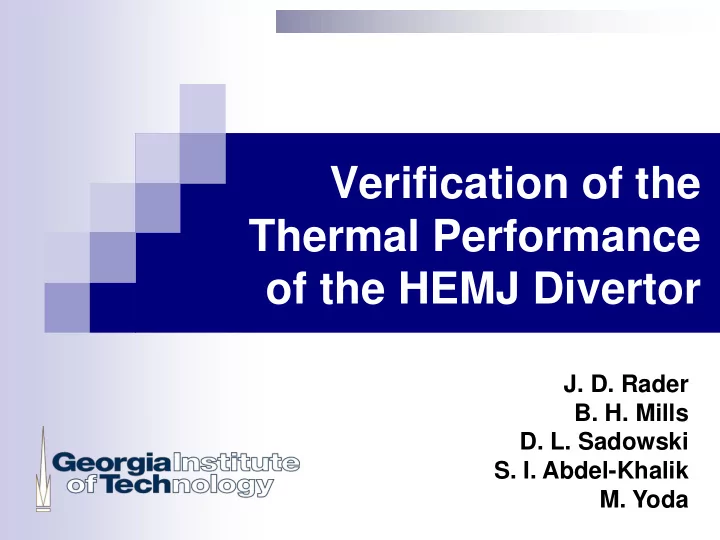

Verification of the Thermal Performance of the HEMJ Divertor J. D. Rader B. H. Mills D. L. Sadowski S. I. Abdel-Khalik M. Yoda
Objectives Update previous predictions of the thermal performance of the helium-cooled multi-jet (HEMJ) modular divertor design Recent results on finger-type divertor dynamic similarity requires matching non-dimensional coolant flow rate Re and ratio of divertor to coolant thermal conductivities Perform experiments on steel and brass HEMJ-like test sections cooled by helium, air, or argon Incident heat fluxes q ≤ 3 MW/m2 Following previous approach, extrapolate results to prototypical conditions to obtain parametric design curves for HEMJ Max. heat flux at given max. pressure boundary temperature Pressure drop (loss coefficient K L ) at prototypical Re 2 Jordan Rader - rader@gatech.edu
Previous Experiments Experiments with He and Ar to validate ■ Air procedure ♦ Argon ● Helium He Nu did not match air, Ar Nu Similarity not achieved matching only Re Account for changes in conduction vs. convection [Mills et al. (2012)] Thermal conductivity ratio, κ 3 Jordan Rader - rader@gatech.edu
HEMJ Divertor HEMJ Accommodate q > 10 MW/m 2 18 mm [Ihli et al. 05; Weathers 07; Crosatti 08] Tile Hot He enters at 10 MPa, cools W tile W as an array of impinging jets Φ 15 mm Require many modules (~5×10 5 for HEMJ) to cover O (100 m 2 ) divertor W-alloy 18 mm Steel Φ 15 mm Hexagonal Tiles 4 Jordan Rader - rader@gatech.edu
GT Test Module q Φ 17 Φ 15 Brass and steel thimbles (pressure boundary) cooled by helium (He), air, Thimble 6 TCs argon (Ar) at near-ambient temperatures Prototypical conditions: Re = 2.16 10 4 (mass flow rate ṁ = 6.8 g/s), κ = 340 Experiments: Re = 8 10 3 − 6 10 4 0.9 Φ 9.54 κ k s / k = 360 − 7000 Incident heat flux q ≤ 3.0 MW/m 2 (torch), Jet Cartridge q ≤ 0.9 MW/m 2 (electrical) Measure temperatures near cooled surface with embedded thermocouples (TC) T C , pressure drop across module p 5 Jordan Rader - rader@gatech.edu
Nu v Re Heat flux based on energy balance of 400 coolant HTC assumes all Increasing κ 300 heat absorbed Nu through cooled surface 200 Doesn’t take ● Ar Brass , κ ≈ 7000 ♦ Air Brass , κ ≈ 5000 conduction into 100 ○ Ar Steel , κ ≈ 3000 account ◊ Air Steel, κ ≈ 2000 Each scenario ■ He Brass , κ ≈ 900 □ He Steel , κ ≈ 3 60 shows its own trend 0 0 1 2 3 4 5 Cases arranged by κ Re / 10 4 6 Jordan Rader - rader@gatech.edu
Accounting for κ Multilinear curve 80 fitting assuming 70 power law 60 Nearly all data fits Nu / κ 0.200 within ± 10% 50 Prototypical values: 40 Re = 21,600 κ = 340 ● Ar Brass , κ ≈ 7000 30 ♦ Air Brass , κ ≈ 5000 20 ○ Ar Steel , κ ≈ 3000 ◊ Air Steel, κ ≈ 2000 10 ■ He Brass , κ ≈ 900 □ He Steel , κ ≈ 3 60 0 0 1 2 3 4 5 Re / 10 4 7 Jordan Rader - rader@gatech.edu
Pressure Loss Coefficient Pressure loss 4 coefficient K L 3 Hydraulic K L 2 parameter ● Ar Brass , κ ≈ 7000 independent of κ ♦ Air Brass , κ ≈ 5000 ○ Ar Steel , κ ≈ 3000 Correlate to Re 1 ◊ Air Steel, κ ≈ 2000 ■ He Brass , κ ≈ 900 □ He Steel , κ ≈ 3 60 0 0 1 2 3 4 5 Re / 10 4 8 Jordan Rader - rader@gatech.edu
Prototypical Conditions Use Nu = ƒ( Re , κ ) and K L = ƒ( Re ) to calculate performance for a range of high pressure/temperature operating conditions Lines of constant pressure boundary temperature, T s , Use Nu correlation to calculate q max T in = 600 ° C T s = 1200 ° C Area changes result in q focusing from tile to pressure boundary Loss coefficient K L gives pressure drop for prototype p p Lines of constant pumping power as fraction of incident thermal power, β Desire to have β < 10% 9 Jordan Rader - rader@gatech.edu
Performance Curves 25 1300 °C 15% 20% 1200 °C 20 q max [MW/m 2 ] 10% 1100 °C 5% 15 10 5 0 0.5 1.5 2.5 3.5 4.5 Re / 10 4 10 Jordan Rader - rader@gatech.edu
Summary Seven experimental configurations HEMJ shows similar conduction/convection characteristics as the previous finger-type design Parametric design curves were created to aid in further design iterations and to account for changes in operating conditions For β < 10% and T s < 1200 °C → Re < 2.5 10 4 , q < 15.5 MW/m 2 and q t < 13 MW/m 2 These studies show that thermal conductivity ratio methodology can be applied to other divertor designs with similar geometries/heat transfer paths Performance verification with dynamically similar experiments over a wide range of conditions 11 Jordan Rader - rader@gatech.edu
Recommend
More recommend